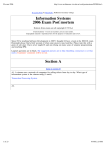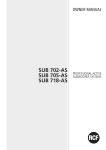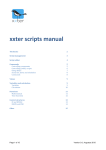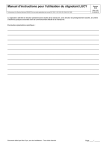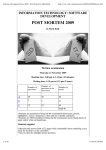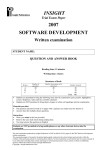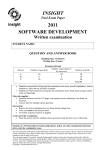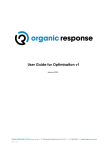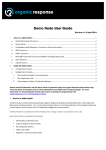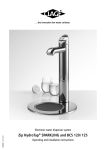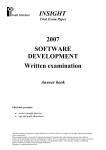Download 2006 Written examination VCE Information Systems
Transcript
Victorian Certificate of Education 2006 SUPERVISOR TO ATTACH PROCESSING LABEL HERE STUDENT NUMBER Letter Figures Words INFORMATION SYSTEMS Written examination Thursday 9 November 2006 Reading time: 11.45 am to 12.00 noon (15 minutes) Writing time: 12.00 noon to 2.00 pm (2 hours) QUESTION AND ANSWER BOOK Structure of book Section Number of questions Number of questions to be answered A B 10 17 10 17 Number of marks 25 75 Total 100 • Students are permitted to bring into the examination room: pens, pencils, highlighters, erasers, sharpeners, rulers and one scientific calculator. • Students are NOT permitted to bring into the examination room: blank sheets of paper and/or white out liquid/tape. Materials supplied • Question and answer book of 23 pages with a detachable insert containing a case study for Section B in the centrefold. Instructions • Remove the insert containing the case study during reading time. • Write your student number in the space provided above on this page. • All written responses must be in English. Students are NOT permitted to bring mobile phones and/or any other unauthorised electronic devices into the examination room. © VICTORIAN CURRICULUM AND ASSESSMENT AUTHORITY 2006 2006 INFOSYS EXAM 2 SECTION A – Short answer questions Instructions for Section A Answer all questions in the spaces provided. Question 1 A cinema uses a network of computers for selling tickets from day to day. What type of information system is the cinema using? 1 mark Question 2 The diagram below shows the layout for a computer network used in a hairdressing salon. network floorplan for a hairdressing salon switch fileserver legend – wall outlets modem two sockets four sockets standard phone socket all cabling CAT-5 RJ-45 administration computer counter a. State the topology of the network above. 1 mark b. State the type of network used above. 1 mark SECTION A – continued 3 2006 INFOSYS EXAM Question 3 Describe the major difference between the functions of a switch and a modem in a network. 1 mark Question 4 A network operating system provides services to network administrators and users. State two important services you would expect to be provided: one for the administrator and one for the user. Administrator User 2 marks Question 5 Link each of these scenarios with one of the following stages of the systems development life cycle. analysis, design, development, implementation, evaluation A network administrator identifies the error rate of his organisation’s Internet connection. A school replaces old computers in the computer room with new ones during the school holidays. A graphics company identifies some concerns in the way it currently stores and accesses past customers’ details. 3 marks SECTION A – continued TURN OVER 2006 INFOSYS EXAM 4 Question 6 A company, No Blots, supplies ink cartridges for printers which are sold only through the Internet. When customers place an order, the order is checked, a confirmation is sent back to the customer and the details of the order are sent to the warehouse. The diagram below shows the data flow diagram (DFD) for the No Blots online purchasing system. The diagram does not show the data sources and destinations. cust ome r_or der packing_info at d date vali der or irm ion _d at a confirm order orders r stock fo order nf process order val ida ord ted er co validate order stock validated order stock for order a. In a DFD a circle represents a process. Briefly explain what is meant by a process. 1 mark b. In the DFD, what do the symbols labelled stock and orders represent? 1 mark c. Complete the context diagram below for the No Blots system. cust ome r_or der no blots online purchasing system warehouse 3 marks SECTION A – continued 5 2006 INFOSYS EXAM Question 7 A computerised machine sorts fruit by weight. It uses a program that directs the fruit through three different gates according to weight. Below is a small segment of that program. message ! “Fruit is undersized” fruit_count ! 0 Repeat good_fruit ! true Close all gates Input (fruit_weight) If (fruit_weight > 30.00) then Open (gate1) fruit_count ! fruit_count + 1 Else If (fruit_weight > 20.00) then Open (gate2) fruit_count ! fruit_count + 1 Else good_fruit ! false Open (gate3) Endif Endif If not (good_fruit) then Output (message) Endif Until eof ***end of fruit Output (fruit_count) a. Identify each variable shown in the table below as one of the following variable types: text, date, boolean, integer, floating point. Variable Type fruit_count message good_fruit 3 marks b. The code is to be written as a procedure within a larger program. The programmer decides to name the procedure ‘helen’ in honour of his girlfriend. Briefly explain why this is a poor choice of name for the procedure. 1 mark SECTION A – continued TURN OVER 2006 INFOSYS EXAM 6 Question 8 Explain the difference between Read Only Memory (ROM) and Random Access Memory (RAM). 2 marks Question 9 Describe how a router can help make a large network run more efficiently. 2 marks Question 10 A company requires a particular task to be carried out using a computer. It has a choice of two programs, A and B. The company would like to evaluate both programs so that it can decide which to purchase. Several criteria can be used to evaluate software, including effectiveness, efficiency, maintainability, reliability, usability. The company will perform three trials, each trial measuring a different criterion. The trials are shown in the table below. For each trial, state which of the criteria listed above is being measured. Trial Criterion being measured Carefully examine the user interface of each program. Give the same task to both programs and record the time each takes to complete it. Have each program run the same task 1000 times and count how many times each crashes. 3 marks Total 25 marks END OF SECTION A 7 2006 INFOSYS EXAM SECTION B – Case study Instructions for Section B Answer all questions in the spaces provided. Remove the case study insert and read all the information provided before you answer these questions. Answers must apply to the case study. Lucy has decided she needs some help to introduce her new computer climate control system for her greenhouses. She employs a system analyst, Susan, and outlines her current system and what she would like to achieve with the new system. Question 1 Susan asks Lucy for technical information about the sensors used in her current system, but Lucy cannot help her. a. Identify a primary source from which Susan can obtain more information about the sensors. 1 mark b. State two examples of the technical information Susan can expect to obtain from the primary source. 2 marks SECTION B – continued TURN OVER 2006 INFOSYS EXAM 8 Question 2 Lucy describes the temperature control to Susan. The temperature in a greenhouse room is constantly monitored and if it falls below 19°C a heater is turned on. If the temperature rises above 21°C the heater is turned off. When the temperature goes over 25°C vents are opened to allow fresh air into the room and if it gets hotter than 29°C evaporative cooling is turned on. Once the temperature drops below 24°C vents are closed and cooling stops. Susan finds this description confusing so she documents this process with a Nassi-Shneiderman (NS) diagram. Susan’s NS diagram is shown below. Five items are missing from it. From the following list choose only five items and write each item in the correct place in the diagram. 1. 2. 3. 4. 5. 6. 7. 8. turn water on turn heater off turn evaporative cooling on temperature > 30°C temperature > 29°C temperature < 24°C temperature < 19°C monitor temperature Do forever Read temperature yes turn heater on no temperature > 21°C yes no temperature > 25°C yes no open vents yes yes no no close vents turn evaporative cooling off 5 marks SECTION B – continued 9 2006 INFOSYS EXAM Question 3 Lucy has seen that the Dutch system, as discussed in the case study, is robust and reliable. She would like to combine parts of this system with her current system but feels further investigation is required. By referring to Lucy’s current system, describe two further factors about the Dutch equipment that Lucy will need to investigate. Explain why each of these factors needs investigation. Factors Need for investigation 4 marks SECTION B – continued TURN OVER 2006 INFOSYS EXAM 10 Question 4 Susan has discovered a shareware program on the Internet that appears to suit Lucy’s needs. The program uses a number of standard interface screens that will allow Lucy to make adjustments to the conditions in the greenhouses. Other screens are used to alert Lucy to problems in the greenhouses. The following screen is a typical data entry screen. Lucy thinks that this screen has a major design fault. a. Identify this fault. 1 mark b. Suggest how the fault can be corrected. 1 mark SECTION B – Question 4 – continued 11 2006 INFOSYS EXAM The following screen is used to alert Lucy to problems with the growing conditions in the greenhouses. Lucy thinks that this screen also has a major design fault. c. Identify this fault. 1 mark d. Suggest how the fault can be corrected. 1 mark SECTION B – continued TURN OVER 2006 INFOSYS EXAM 12 Question 5 Lucy has decided against the shareware program and buys the Dutch software. After installing it, her friend Peter, who is a programmer, is convinced that the Dutch software has some major faults. He has offered to fix these problems for Lucy, free of charge. Explain the legal obligations and/or ethical considerations that Lucy should think about before she accepts or rejects Peter’s offer to alter the program code. 4 marks SECTION B – continued 13 2006 INFOSYS EXAM After checking carefully Lucy is satisfied that she can allow Peter to fix problems and make any changes that he would like. Question 6 Lucy wants to receive an alert message if the humidity drops below 20% or rises above 80%. Peter writes a program module to do this and tests it with the following test data. a. Test data Expected results 19 Alert 25 No Alert 80 No Alert Susan is not satisfied that this data has fully tested the program module. Explain why. 2 marks b. Explain exactly what Peter needs to do to satisfy Susan’s concerns. 2 marks SECTION B – continued TURN OVER 2006 INFOSYS EXAM 14 Question 7 One of the errors that Peter has found is in the code to control the shade curtain motor. For her flowering orchids, Lucy wants the shade curtain to be closed if the light exceeds 15 000 lux (MaxLight). She also wants the shade curtain closed when the temperature exceeds 33°C (MaxTemp). The curtain should only be opened when the light falls below 7 000 lux (MinLight) and when the temperature drops below 30°C (MinTemp). The light and temperature values will vary depending on the plants grown in each greenhouse ‘room’. Peter has found that the code follows the algorithm below. Begin If Temperature > MaxTemp Or Light >MaxLight Then CurtainMotor (Close) Endif If Temperature < MinTemp Or Light < MinLight Then CurtainMotor (Open) Endif End a. Below is a testing table. Work out the action that the algorithm finally produces and complete the last column. Action required temperature light curtain motor 34 16 000 Close 34 5 000 Close 29 5 000 Open 29 16 000 Close Action produced by algorithm curtain motor 4 marks b. A line in the algorithm contains a logic error. Identify that line by writing it out in full. 1 mark c. Describe how this error can be corrected. 1 mark SECTION B – continued 15 2006 INFOSYS EXAM Question 8 The new system requires a computer in each nursery to control the greenhouse climates. The orchids may be damaged if these computers fail to work. Each computer will be placed in a small enclosed area as shown in Figure 3 of the case study. a. List three separate hazards to which these computers will be exposed. 1. 2. 3. 3 marks b. Select one hazard and describe why this is a concern for Lucy. 2 marks c. Describe how Lucy should protect the computers from the hazard described in part b. 2 marks SECTION B – continued TURN OVER 2006 INFOSYS EXAM 16 Question 9 Lucy wishes to connect the computer in the local nursery with a computer in her house so she can monitor the greenhouse from her study. The distance is approximately 30 metres. She has two choices. Option 1: Option 2: to connect via CAT-5 cable to set up a wireless link Select the better option for Lucy. Justify your selection by comparing the two options. 2 marks SECTION B – continued 17 2006 INFOSYS EXAM Question 10 Lucy needs to monitor her new remote nursery as described in the case study insert. She needs to connect the nursery computer (five kilometres away) to her home computer. She expects the remote nursery computer to transmit approximately 2 KB of data every five minutes to the home computer. She has a phone service to the remote nursery. She is investigating a number of options for this task. a. What type of network does Lucy want to set up? 1 mark b. For each of the following three options outline one strength. Option 1: Use dial up Internet – get the computer to use the Internet by dialling in every 5 minutes. Option 2: Use broadband instead of dial up Internet. Option 3: Set up a microwave link. 3 marks c. Select the best possible option for Lucy. Justify your selection by discussing the three options above. 3 marks SECTION B – continued TURN OVER 2006 INFOSYS EXAM 18 Question 11 Lucy wants to be able to compare the humidity, temperature and light measurements from different times of the year so she can identify the best growing conditions for her orchids. Peter has agreed to write a program that will store the data for this purpose. His preferred programming language will only allow data files to be organised for sequential or random access. Peter decides to use a random access file. Compare the two access methods and comment on the suitability of Peter’s choice for Lucy’s purpose. 3 marks SECTION B – continued 19 2006 INFOSYS EXAM Question 12 Lucy has a huge project to convert her current greenhouse, and to include her new greenhouses into the new computer climate controlled system. For each greenhouse, she has to coordinate tasks such as • • • • • a. purchasing new equipment removing old equipment installing new equipment including computers, cabling and sensors installing the software setting up the network. Which project management tool would be most suitable for Lucy to use to plan her project? 1 mark b. Describe three ways in which this project management tool will help Lucy manage the project. 3 marks SECTION B – continued TURN OVER 2006 INFOSYS EXAM 20 Question 13 Lucy has decided to trial the new computerised greenhouse climate control system in her local nursery first before installing it in her remote nursery. She also considered two other methods. • running both the new and current system at the same time for a month • changing over to the new system in both nurseries all at once a. Identify the type of changeover method Lucy has decided to use. 1 mark b. Explain why this method is a better choice for Lucy than the other two options. 3 marks SECTION B – continued 21 2006 INFOSYS EXAM Question 14 Lucy has read a great deal lately about viruses that can attack home computers through Internet connections. Lucy is relying on her Internet connection to monitor her remote nursery’s greenhouse conditions and to alert her of any problems. It is important that her computer is always turned on and connected to the Internet. Describe two ways Lucy could protect her computer against attack from viruses. 1. 2. 4 marks Question 15 Lucy had to be rushed to hospital for an appendix operation. She was forced to leave her nurseries in the hands of a fellow orchid grower, Edmund. Edmund is very familiar with looking after orchids but has never used a system like Lucy’s new greenhouse climate control system. Lucy had no time to give Edmund instructions on running the system so she told Edmund where to find the 365-page user manual. a. Describe another form of user documentation that should have been available for Lucy to give to Edmund. 1 mark b. Identify the main topics this documentation should contain. 3 marks SECTION B – continued TURN OVER 2006 INFOSYS EXAM 22 Question 16 After Lucy’s system had been set up and working for about three months, a data security company contacted Lucy about backing up her data. This company uses the Internet to transfer customer data to their storage facilities. The company has made the following three claims about their service. Claim 1: Lucy would not need to worry about the backup, they would do it all for her. Claim 2: Lucy would always be able to access the backup. Claim 3: They would keep Lucy’s backup on a very secure site that is well away from the nurseries. Discuss what Lucy needs to investigate before accepting each claim. Claim 1 Claim 2 Claim 3 2 + 2 + 2 = 6 marks SECTION B – continued 23 2006 INFOSYS EXAM Question 17 When the system was being designed, Lucy produced a list of objectives for the new system. Objective 1: The temperature, light and humidity do not go outside the set limits. Objective 2: No more than two errors in a month will be recorded. Objective 3: Record all errors and immediately send an alert message to her mobile phone. After six months of operation, Lucy thinks that her new greenhouse climate control system is a success. However, she wants some data to support her feeling, so she has checked the error log from both nursery computers. The content of the error log is shown below. 12-3-2006 15-3-2006 27-5-2006 31-8-2006 03-9-2006 a. 17:31:57 03:54:29 13:45:11 07:34:51 14:04:33 vents stuck mist sprayers malfunction greenhouse too hot vents stuck greenhouse too bright action required action required action required action required action required For Objective 1, indicate the data that informs Lucy that the objective is not being met. 1 mark b. For Objective 2, indicate the data that informs Lucy that the objective is being met. 1 mark c. What additional data needs to be checked to evaluate if Objective 3 has been met? Explain. 2 marks END OF QUESTION AND ANSWER BOOK Total 75 marks 2006 INFOSYS EXAM CASE STUDY INSERT Please remove from the centre of this book during reading time. Lucy is the owner of Lucky Orchids which specialises in growing orchids for the pot plant market. Her nursery, a 600 square metre heated greenhouse, is located next to her house in country Victoria. At most times during the year there are 100 000 plants growing in the nursery. The orchids are worth about $2 000 000. Lucy’s current system So she can grow the best orchids, Lucy has to have different growing conditions at different stages of a plant’s life. For example, her seedlings and younger plants require less light, a higher temperature and higher humidity than older plants. To achieve this, Lucy has divided the greenhouse into three rooms. Each room has its own set of climate control units as shown in Figure 1 on the following page. They can be set according to the needs of the plants in that room. For example, for Lucy’s flowering plants • if the light exceeds 15 000 lux (a measure of light brightness), shade curtains are automatically pulled across the roof • if the humidity rises above 80%, the mist sprayers are turned off • if the temperature is above 25°C, vents are opened to allow fresh air into the greenhouse. Each unit operates independently and automatically although sometimes one will fail. This can have serious consequences for Lucy’s plants and she can only check each unit by going into the greenhouse and reading various climate gauges in the greenhouse. For example, if heaters fail at night she will not know until the morning when she physically checks the thermometer. Cool overnight temperatures will cause her plants to grow more slowly or even kill them. Failure to control light or humidity may also cause damage. Unfortunately, Lucy cannot be in the nursery every day because of personal and business commitments. TURN OVER 2006 INFOSYS EXAM light control unit light sensor open close shade curtains temperature control unit on off temperature sensor on off open close heater evaporative cooler vents humidity control unit humidity sensor on off Figure 1. mist sprayers Climate control units for one room With the current system, Lucy can grow plants from seedling to flowering in 2 12 years. On a recent trip to Holland, to purchase new varieties of plants, she noted that Dutch nurseries were growing plants from seedling to flowering in 1 12 to 2 years. The reason for this is that the climate in their greenhouses is computer controlled. All the sensors and climate control devices are connected to a computer. A computer program then maintains ideal growing conditions. For example, if the temperature gets too high, shade curtains are activated regardless of the light level, and in extreme conditions, mist sprayers are also turned on, even if humidity is above 80%. Lucy’s new system Lucy recently purchased a new nursery five kilometres from her house. It has unheated greenhouses covering 3000 square metres of land. Because her new greenhouses will have to be upgraded for her orchids, Lucy decides that she wants to introduce a computer controlled climate system into both her existing local nursery and her new remote nursery. She would like this computer climate control system to • combine control of all climate devices to produce better conditions for orchid growth • allow her to remotely check and alter the conditions in each greenhouse room in both nurseries • record errors and send an alert message to her mobile phone if something fails. 2006 INFOSYS EXAM Lucy imagines that the new system will be something like that shown in Figures 2 and 3. equipment in a room open light sensor shade curtains close on heater off temperature sensor on evaporative cooler off open vents close humidity sensor on mist sprayers off to greenhouse computer Figure 2. Proposed equipment plan for a room local nursery Lucy’s house greenhouse 1 room equipment room equipment room equipment 30 m room 1 room 2 room 3 50 00 m (5 km ) computer for all greenhouses in remote nursery remote nursery greenhouse 2 room 1 room 2 greenhouse 3 room 1 Figure 3. Proposed plan for the two nurseries END OF CASE STUDY INSERT room 2


























